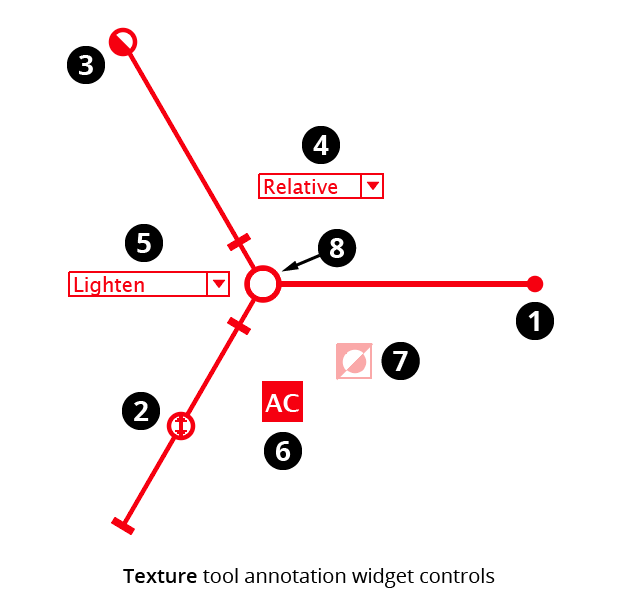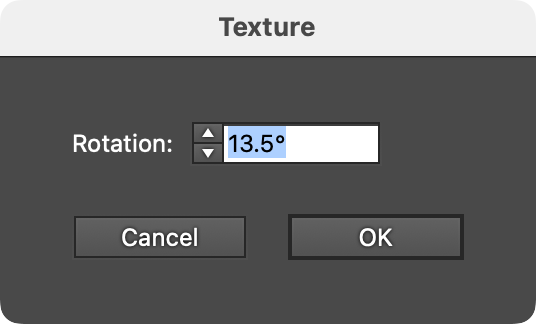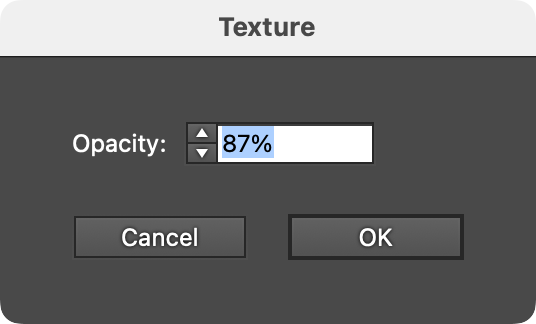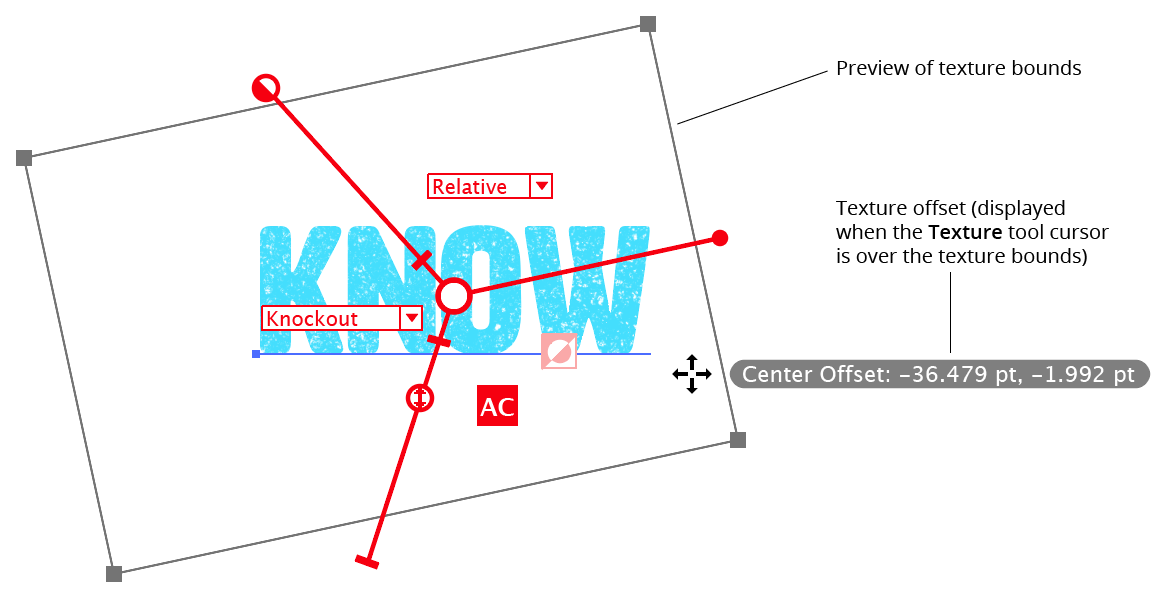 Texture Annotation Widget
Texture Annotation Widget
The annotated widget consists of multiple controls. For all controls, the texture will update after the mouse button is released.

Texture Annotations
1. Rotation arm and control
Dragging the rotation control changes the angle of the texture. The texture’s current angle of rotation is displayed next to the cursor when hovering over or close to the rotation control:

Texture Rotation Display
Doubleclicking the rotation control will bring up a dialog in which the texture’s angle of rotation can be specified numerically:

Texture Rotation Dialog
2. Scale Slider
Dragging the thumb changes the scale of the texture (keeping its center stationary), from 10000% at the outside end of the slider to 1% at the inside end. The texture’s current scaling and effective resolution is displayed next to the cursor when hovering over or close to the scale slider:

Texture Scale Display
Doubleclicking the scale slider thumb control will bring up a dialog in which the texture’s scale can be specified numerically, either as a percentage or by specifying the desired effective resolution, in pixels per inch:

Texture Scale Dialog
The default Scale setting can be set in the preferences dialog (see Texture: Preferences). Textures are always scaled the same in the horizontal and vertical directions.
3. Opacity Slider
Dragging the thumb changes the opacity of the texture, from 100% at the outside end of the slider to 0% at the inside end. The texture’s current opacity is displayed next to the cursor when hovering over or close to the opacity slider:

Texture Opacity Display
Doubleclicking the opacity slider thumb control will bring up a dialog in which the texture’s opacity can be specified numerically:

Texture Opacity Dialog
4. Position Mode Menu
Chooses the mode of positioning the texture. In Relative mode (the default), the texture’s center is positioned relative to the center of the bounding box of the art; if the art is moved, the texture will move along with it. In Absolute mode, the texture’s center is positioned at specific coordinates on the artboard; the texture will not move when the art is moved or its bounding box is changed (unless Auto-Cover is enabled; see below).
5. Blending Mode Menu
Controls the blending mode of the texture. It consists of the same sixteen blending modes that are available in the native Transparency panel, plus a special mode: Knockout. In Knockout mode, the darkness of the texture controls the opacity of the art to which it is applied; solid black areas make the art completely transparent (“knocking it out”) and therefore allowing art below it to show through.

Texture Blending Mode Examples
In the Texture Manager, each texture may be assigned an Initial Blending Mode, which is the mode given to the texture as a default (see Texture: Texture Manager).
6. Autocover Button
Toggles the Autocover parameter of the texture. When enabled, indicated by an undimmed “AC” icon, nonrepeating textures will be automatically moved and/or enlarged such that they always completely cover the bounding box of the artwork (plus any specified padding). The default Autocover setting can be set in the preferences dialog (see Texture: Preferences).
7. Invert Button
Toggles the Invert state of the texture. When enabled, indicated by an undimmed icon, the color of the texture is inverted.
8. Center control
Clicking the center control of an untargeted texture targets it.
When dragging a control on the annotated widget, the following keypresses apply:
Shift: Constrains the control’s value to a “nice” value. For Rotation, this is angles that are multiples of 45° away from the general constrain angle. For Opacity, this is steps of 10%. For Scale, this is integer percentages.
Command/Ctrl: Enables “Slow-Drag,” which moves the control as if all cursor movements were reduced by a value specified in the tool preferences (with a default of 10), allowing for finer control.
Space: Temporarily hides the tool annotations.
C: Changes the annotation color.
In addition to the annotated widget, the bounds of the targeted texture are displayed as a gray rectangle:

Texture Bounds Annotation
This bounds annotation may be manipulated with the Texture tool in several ways:
a. The inside of the rectangle may be dragged to reposition the texture (hold
Shiftto constrain the movement);doubleclickinginside it allows the position to be specified numerically.b. The edges and corners of the rectangle may be dragged to resize the texture; by default, this is done keeping the opposite edge/corner stationary, but holding
Option/Altwill resize it from the center.c. Hovering the cursor just outside one of the corners of the rectangle allows rotation of the texture, either by dragging (similarly to rotating an art object using its bounding box, with
Shiftconstraining the angle of rotation) or bydoubleclickingto set the rotation numerically.
If the texture is repeating, the rectangle annotation’s borders are drawn with a dashed line.
While the rectangle bounds of the texture updates in real time when rotated or resized, the actual texture will not be updated until the mouse button is released.
When nothing is selected, the Texture tool can be used to select artwork, by either marquee-dragging over it or by clicking on it.
